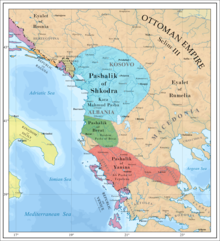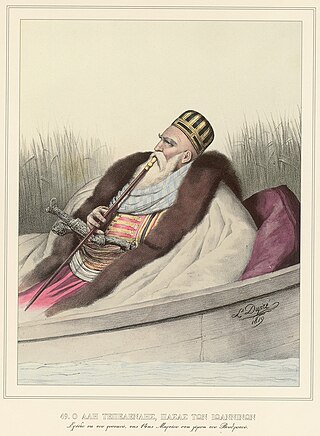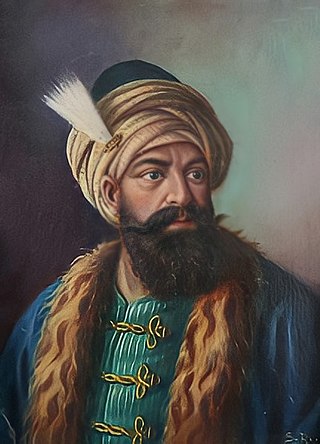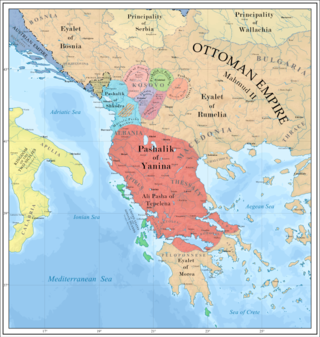Ruler

Ibrahim Pasha of Avlona became ruler of the pashalik of Berat after the death of Ahmet Kurt Pasha with whom he had been a close ally. As this territory was part of Middle Albania, Ali Pasha of Ioannina saw him as a threat.
Ibrahim Pasha of Berat was the second and last ruler of the Pashalik of Berat, in office from 1787 to 1809.

Ibrahim Pasha of Avlona became ruler of the pashalik of Berat after the death of Ahmet Kurt Pasha with whom he had been a close ally. As this territory was part of Middle Albania, Ali Pasha of Ioannina saw him as a threat.
After some fruitless negotiation, Ibrahim Pasha sent a body of troops under the command of his brother Sephir, bey of Avlona. Against these, Ali summoned the armatoles of Thessaly; and after villages had been burnt, peasants robbed and hanged, and flocks carried off on both sides, peace was made. Ibrahim gave his daughter in marriage to Mukhtar, the eldest son of Ali, and the disputed territory as her dower. As Sephir bey had displayed qualities which might prove formidable hereafter, Ali contrived to have him poisoned by a physician; and, after his usual fashion, he hanged the agent of the crime, that no witness might remain of it. [1] In 1808, Ali Pasha defeated Ibrahim Pasha, incorporating its territory in the Pashalik of Janina.
The local population and the tradesmen neither pay the kharatj nor any other tax, except a contribution of thirty paras a head per annum to Ibrahim Pasha of Berat, for the liberty of trading to his ports. The right of pasturage on the lands of the town of Khimara, that of gathering velanidhi[ clarification needed ] on the mountains, and that of fishing in the northern bay of Palerimo are enjoyed in common by all the inhabitants. Maize is grown in the plain adjacent to the northern beach, where the two torrents, which embrace the town, overflow in the winter, and prepare the land for receiving that grain.

Ottoman Albania refers to a period in Albanian history from the Ottoman conquest in the late 15th century to the Albanian declaration of Independence and official secession from the Ottoman Empire in 1912. The Ottomans first entered Albania in 1385 upon the invitation of the Albanian noble Karl Thopia to suppress the forces of the noble Balša II during the battle of Savra. They had some previous influence in some Albanian regions after the battle of Savra in 1385 but not direct control. The Ottomans placed garrisons throughout southern Albania by 1420s and established formal jurisdiction in central Albania by 1431. Even though The Ottomans claimed rule of all Albanian lands, most Albanian ethnic territories were still governed by medieval Albanian nobility who were free of Ottoman rule. The Sanjak of Albania was established in 1420 or 1430 controlling mostly central Albania, while Ottoman rule became more consolidated in 1481, after the fall of Shkodra and League of Lezhe with the country being mostly free in the period of 1443–1481. Albanians revolted again in 1481 but the Ottomans finally controlled Albania by 1488.

Ali Pasha, or Ali Pasha of Tepelena, commonly known as Ali Pasha of Ioannina, was an Albanian ruler who served as Ottoman pasha of the Pashalik of Yanina, a large part of western Rumelia. Under his rule, it acquired a high degree of autonomy and even managed to stay de facto independent. The capital of the Pashalik was Ioannina, which, along with Tepelena, was Ali's headquarters. Conceiving his territory in increasingly independent terms, Ali Pasha's correspondence and foreign Western correspondence frequently refer to the territories under Ali's control as "Albania." This, by Ali's definition, included central and southern Albania, and parts of mainland Greece; in particular, most of the district of Epirus and the western parts of Thessaly and Macedonia. He managed to stretch his control over the sanjaks of Yanina, Delvina, Vlora and Berat, Elbasan, Ohrid and Monastir, Görice, and Tirhala. Ali was granted the Sanjak of Tirhala in 1787, and he delegated its government in 1788 to his second-born Veli Pasha, who also became Pasha of the Morea Eyalet in 1807. Ali's eldest son, Muhtar Pasha, was granted the Sanjak of Karli-Eli and the Sanjak of Eğriboz in 1792, stretching for the first time Ali's control down to Livadia and the Gulf of Corinth, except Attica. Muhtar Pasha also became governor of the Sanjak of Ohrid in 1796–7 and of the Sanjak of Vlora and Berat in 1810.

Kosmas the Aetolian, sometimes Cosmas the Aetolian or Patrokosmas "Father Kosmas", was a monk in the Greek Orthodox Church. He is recognized as one of the originators of the twentieth-century religious movements in Greece. He is also noted for his prophesies. Kosmas held negative views on speakers of Aromanian and Arvanitika, and urged them to abandon their language and adopt Greek.

Kara Mahmud Pasha was a hereditary Ottoman Albanian governor (mutasarrıf) of the Pashalik of Scutari and de jure ruler of Albania. He belonged to the Ottoman Albanian Bushati family.
Mustafa Pasha Bushatli, called Ishkodrali, was a semi-independent Albanian Ottoman statesman, the last hereditary governor of the Pashalik of Scutari. In 1810 he succeeded Ibrahim Bushati and ruled Shkodër until 1831.

Vizier Omer Pasha Vrioni was an Ottoman Albanian military commander and ruler, and a prominent figure in the Greek War of Independence. He succeeded Ali as Pasha of Yanina.

The Pashalik of Yanina, sometimes referred to as the Pashalik of Ioannina or Pashalik of Janina, was an autonomous pashalik within the Ottoman Empire between 1787 and 1822 covering large areas of Albania, Greece, and North Macedonia. Under the Ottoman Albanian ruler Ali Pasha, the pashalik acquired a high degree of autonomy and even managed to stay de facto independent, though this was never officially recognized by the Ottoman Empire. Conceiving his territory in increasingly independent terms, Ali Pasha's correspondence and foreign Western correspondence frequently refer to the territories under Ali's control as Albania.
Mehmed Pasha Bushati was the governor of the Pashalik of Scutari and founder of the Bushatli dynasty of Shkodër

The Pashalik of Berat was a pashalik created in modern-day central Albania by Ahmet Kurt Pasha in 1774 and dissolved after Ahmet's ally, Ibrahim Pasha of Berat was defeated by Ali Pasha in 1809, thus incorporating the pashalik, with the Pashalik of Janina. This pashalik was one of the three pashaliks created by Albanians in the period of Albanian Pashaliks.
Ahmet Kurt Pasha was an Albanian pasha and the founder and the first ruler of the Pashalik of Berat, a semi-autonomous area within the Ottoman Empire. He possibly descends from the Muzaka family, which in the late Middle Ages had founded the Lordship of Berat.

The Albanian Pashaliks were three semi-independent pashaliks ruled by Albanian pashas from 1760 to 1831 and covering the territory of modern Albania, Kosovo, most of Montenegro, southern Serbia, western North Macedonia and most of mainland Greece. The degree of independence of these pashaliks varied over time, from semi-autonomous to de facto independent.
The Massacre of the Albanian beys occurred on 9 August 1830, when around 500 Albanian leaders (beys) and their personal guards were killed by Ottoman forces in the town of Manastir. The massacre led to the weakening of the power of the beys of southern Albania and also set the basis for the destruction of the powerful northern Albanian Pashalik of Scutari.
The Albanian revolts of 1833–1839 took place in Albania as a reaction against the new centralizing policy of Ottoman administration.

The Sanjak of Delvina was one of the sanjaks of the Ottoman Empire which county town was Delvinë but during the 18th century became Gjirokastër, Albania. It was created in the mid-16th century, came under the control of the Pashalik of Yanina during 1785−1822, and was disestablished after the Balkan Wars in 1913. It was divided between Albania Albania and Greece in 1913.

The Sanjak of Avlona was one of the sanjaks of the Ottoman Empire whose county town was Berat in Albania. It was established in 1466, after the construction of the Elbasan Castle of the territory that belonged to the preceding Ottoman sanjak, Sanjak of Albania.
The House of Taushani was an Albanian aristocratic family prominent from the 15th to 19th century. According to prof. Stavri Naci, the most powerful families of Albania that played an important economic and political role were, "in Shkoder, the Bushati and Caushollaj; in Peja, Begollaj; in Elbasan, Taushani and Bicaku; in Vlora, Velabishtaj and Vlora; in Delvina, Kapllanpashalli; in Kruja, Toptani; and in Kavaja, the Alltuni."
Muhtar Pasha was an Ottoman Albanian ruler and the son of Ali Pasha of the increasingly independent Pashalik of Yanina. He was appointed governor of the Sanjak of Karli-Eli and the Sanjak of Eğriboz in 1792, stretching Ali's control down to Livadia and the Gulf of Corinth, except Attica. He also became governor of the Sanjak of Ohrid in 1796–7, and of the Sanjak of Vlorë and Berat in 1810.
The First Scutari-Berat War was a military conflict between the Pashalik of Scutari under Mehmed Pasha Bushati against the Pashalik of Berat under Ahmet Kurt Pasha, who fought over the Sanjak of Durrës in 1775.
Veli Bey was an Albanian clan leader and local ruler in Tepelena during the 18th century. A leading member of the Meçohysaj clan, Veli was appointed as mutasarrıf of the Sanjak of Delvina after a power struggle with his cousins and brothers regarding the inheritance of his deceased father Muhtar Bey. He was also the father of Ali Pasha Tepelena, the eventual ruler of the Pashalik of Yanina.
The Second Scutari-Berat War was a military invasion launched by Mustafa Pasha of the Pashalik of Scutari against the Pashalik of Berat under Ahmet Kurt Pasha.